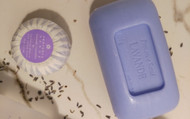Now, if soap is truly made using such a basic process, what’s the deal with the bars upon bars you see lining the shelves at the local supermarket? Can they really be that different from one another?
It’s all in the details. Once saponification has occurred, makers have the chance to add the fun stuff, like fragrance, scrubbers such as seaweed or oatmeal, and emollients or moisturizers, glitter, whatever!. That’s when a soap becomes unique.
For instance, Shea butter is a favorite ingredient of ours because it doesn’t saponify. You mix all your ingredients together, and the Shea butter is in there, but it remains intact. This makes it more likely to linger on the skin as a moisturizer while other ingredients rinse off.
Its bonus moisturizing effect and enhanced lather are why we use it in Baudelaire soaps, like our loofa bars, and why you’ll also find it in the Provence Santé soaps we import from France.
Our honey soaps are another great example. For those, we add lanolin because, like Shea butter, it doesn’t saponify. Lanolin is super slippery and gives the soap a smoother, more elegant feel. It also allows us to do the incredibly fine molding we do with our Royal Jelly soap; the texture makes those really intricate shapes possible.
So, as you can see, a soap is not just a soap. True makers know the secrets that unlock each bar’s full potential, and thoughtfully combined ingredients are what set a soap apart.




